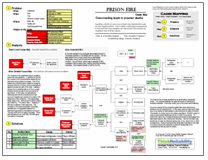An explosion and subsequent fire at a sawmill in British Columbia has killed two workers and injured two dozen more. Although the cause of the explosion is not known, there have been five explosions linked to wood dust in British Columbia since 2009.
A dust explosion results from the presence of combustible dust, such as that created by the sawmilling process. In order for an explosion to occur, the dust must be dispersed into the air but confined by a structure in the presence of oxygen and a spark. (Learn more about dust explosions.)
 To view all the causes that contributed to this tragic explosion, we can examine the incident in a Cause Map, or visual root cause analysis. We begin with the impacts to the goals. The employee deaths and injuries are an impact to the safety goal. This is the primary focus of any issue that results in human death or injury. In addition, the environmental goal was impacted as the smoke migrated to the nearby town. The production goal was impacted due to the shutdown of the facility. The property goal was impacted due to destruction of the sawmill, log processing facility, and sorting facility. Lastly, the investigation and cleanup will impact labor goals.
To view all the causes that contributed to this tragic explosion, we can examine the incident in a Cause Map, or visual root cause analysis. We begin with the impacts to the goals. The employee deaths and injuries are an impact to the safety goal. This is the primary focus of any issue that results in human death or injury. In addition, the environmental goal was impacted as the smoke migrated to the nearby town. The production goal was impacted due to the shutdown of the facility. The property goal was impacted due to destruction of the sawmill, log processing facility, and sorting facility. Lastly, the investigation and cleanup will impact labor goals.
Once we have determined the impacts to the goals, we can ask why questions to determine the cause-and-effect relationships that led to the incident. In this case, the injuries were due to the fire. The fire may have been caused by a dust explosion (explosion due to natural gas leak has been ruled out). In order for a dust explosion to occur, five factors are necessary: 1) presence of combustible dust, 2) oxygen, 3) dust is dispersed into the air, 4) dust particles are confined, and 5) the mixture is ignited.
In this case, the ignition source is not known and, due to the damage at the facility, may never be conclusively determined. Similarly, the cause that resulted in the dust being dispersed may also not be known. The oxygen must be present for worker safety and the dust is confined because it is held within a closed structure. The dust is present because it is created during sawmilling operations. What makes a dust combustible depends on the properties of the dust. This mill was processing pine beetle wood, or wood that was ravaged by beetles. This makes the wood drier, which results in a drier, finer, more combustible dust. Thorough cleaning of any facility that creates potentially combustible dust is a necessity – inadequate cleaning (including dust that may gather on hard-to-access surfaces, such as the ceiling) increases the possibility of an explosion. The union believes that cleaning has been reduced as a result of the economy.
Local government has begun inspections of saw mills but are asking plants to examine potential dust and ignition sources. Reducing dust and ignition sources are the most effective way to reduce risk of dust explosions. Other solutions being considered include adding water to the air to increase humidity and increased ventilation, which can reduce the confinement of the dust and increase cleanliness.
To view the Outline and Cause Map, please click “Download PDF” above.








 After we’ve completed the outline, we build our Cause Map beginning with the goals that were impacted. The goals were impacted by a series of explosions and fires across the ship. These explosions and fires were fueled by jet fuel and bombs that were found on the planes on the flight deck of the carrier. The initiating event was the explosion of a Mk-32 Zuni rocket, which exploded when it overheated due to being put in the exhaust path of an aircraft starting unit.
After we’ve completed the outline, we build our Cause Map beginning with the goals that were impacted. The goals were impacted by a series of explosions and fires across the ship. These explosions and fires were fueled by jet fuel and bombs that were found on the planes on the flight deck of the carrier. The initiating event was the explosion of a Mk-32 Zuni rocket, which exploded when it overheated due to being put in the exhaust path of an aircraft starting unit.